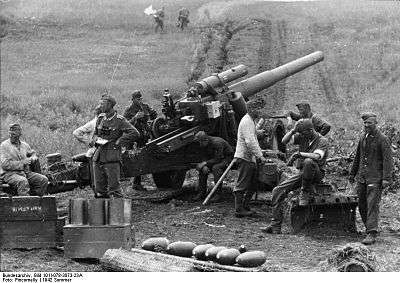Pakfront
The Pakfront was a defensive military tactic developed by the German forces on the Eastern Front during the Second World War. It was named after the phonetic pronunciation of the acronym nomenclature for German towed anti-tank guns, PaK (PanzerabwehrKanone, "tank defense cannon"). The Soviets soon copied the tactic, and used it to great effect at the Battle of Kursk in July 1943.

During the large Soviet armoured attacks on the Eastern front in late 1941–1942, the Germans quickly realised that their anti-tank guns, operating individually or in small groups, and with no central commander, were quickly overwhelmed.
The pakfront was developed to counter this. A group of up to ten guns were placed under the command of one officer. He was responsible for designating targets and directing the fire of his guns. This allowed the Germans to spring particularly effective anti-tank ambushes, with all guns being assigned separate targets and then firing at once, maximizing surprise and minimizing the chance for return fire.
The tactic was found to be extremely effective, and soon the Soviets had copied it, often using multiple pakfronts in co-operation with minefields, anti-tank ditches, and other obstacles to channel the enemy armour into their fields of fire. The Soviets also developed an extension of the ambush tactic in which all the guns could be targeted on one particularly valuable or heavily armored target and fired on command, the combined impacts essentially guaranteeing an instant kill. This technique was especially effective against German command tanks (because it generally caused a catastrophic kill, or K-kill, that minimized any chance for the command team to escape) and heavy vehicles (like the Tiger I) that might have otherwise need dozens of separate hits to disable. To counter the effectiveness of the Soviet pakfront, the Germans developed the panzerkeil ("armoured wedge"), but this offensive tactic had limited effectiveness.
The Soviet method of employing pakfronts included establishing anti-tank zones (Russian: противотанковые районы protivotankovyje rajony) in staggered patterns with multiple pak-groups' (anti-tank base-of-fire points, Russian: противотанковые опорные пункты protivotankovyje opornyje punkty) firing sectors intertwined, to amplify the effect of the tactic.[1]
At the Battle of Kursk in July 1943, Soviet pakfronts slowed the German attack in the south and completely halted the northern German force. The panzerkeil was shown to be an inadequate countermeasure.
References
- ↑ I Fought The Panzerwaffen - The Hot Snow Of The Pakfront - ed. A. Drabkin